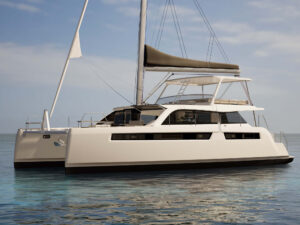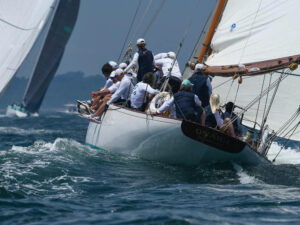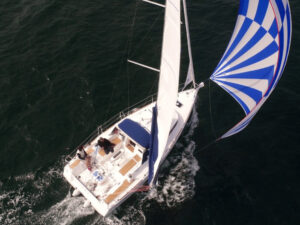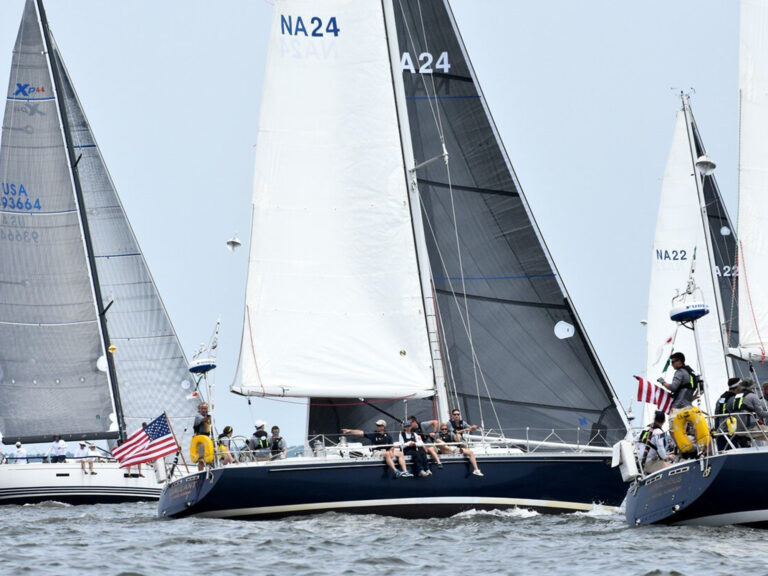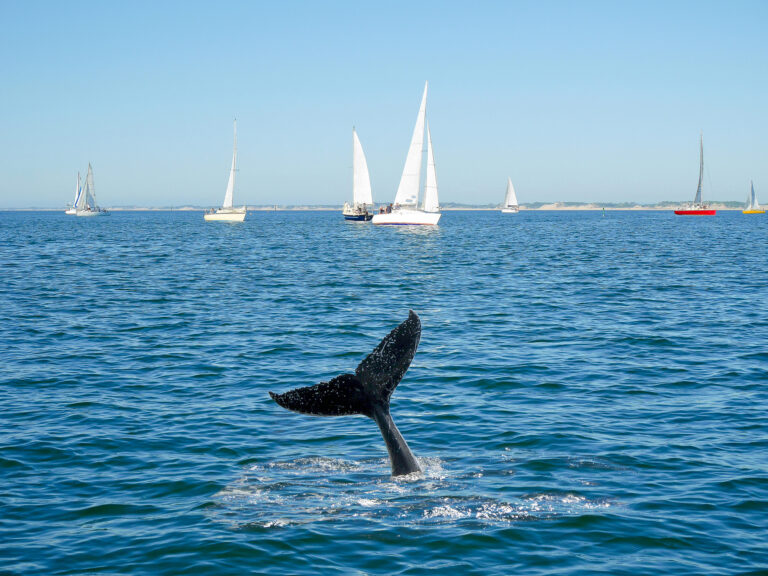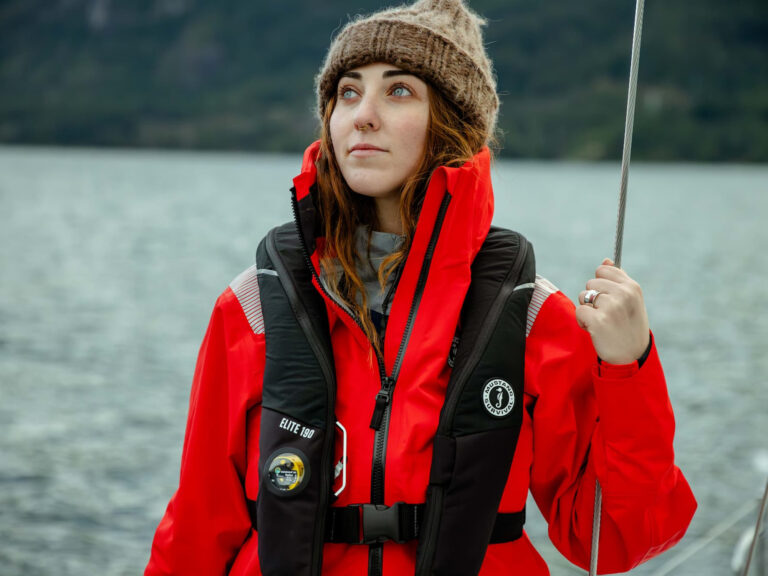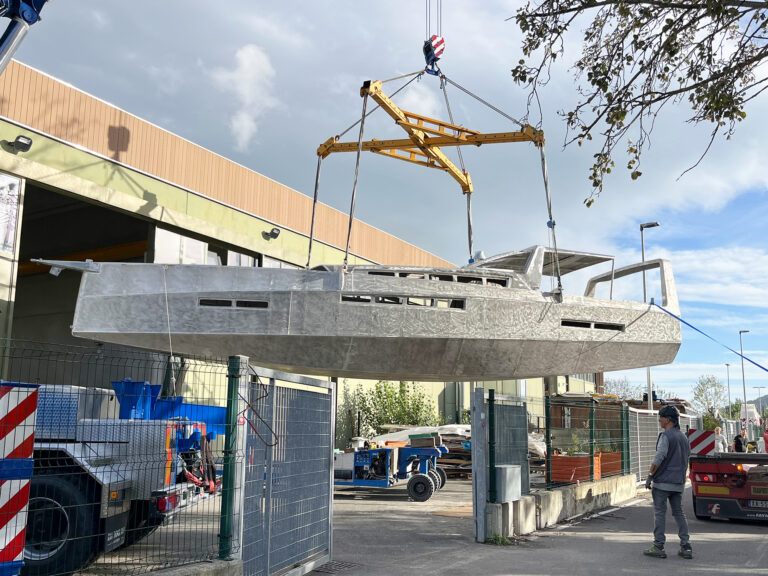
SAS contest winner
Thanks to everyone who shared what lessons they learned when faced with a situation at sea where safety knowledge and skills were put to the test.
First Place – Maxine White “Abandon Ship”
Prize: $200 gift card from Landfall Navigation
It was on the third evening of our passage from Cartagena, Colombia, to the Virgin Islands that we hit a container. We were 150 miles from shore in our 52-foot catamaran and taking on water fast through our port bow. There was no time to think of a repair at sea. Within 20 minutes, we had all five crewmembers in the life raft that was tied with a 60-foot line to the back of the half-submerged vessel. With my husband and I were three novice crewmembers who listened to instructions and did exactly as we asked. The rescue events by a passing freighter were dramatic but within four and a half hours all crew were on board with no injuries. We learned valuable lessons by things we did correctly and things we did wrong.
• The life raft was deployed immediately from the transom and tied to the back of the boat.
• The EPIRB was immediately activated and tied to one of the crew. MAYDAY was called on both SSB and VHF radios with our coordinates. It was frustrating hearing so many people talking on the emergency hailing frequencies, as we had no idea if anyone was hearing us. We had a satellite phone that remained working until the boat batteries went out. Speaking directly to someone on shore was a huge relief. We later learned that the EPIRB signal was picked up and relayed to Coast Guard Group Miami. In addition, 45 stations reported hearing our MAYDAY.
• All crew put on harnesses and life vests; however, many of the life jackets were unreachable below deck in the cabins, and we could not find a fifth one. This was a mistake not having all life jackets readily accessible from the cockpit.
• My husband rushed to the foredeck to retrieve a scuba BCD. Our dinghy was upside down on top of the hatch where the BCD was stored. As soon as he cut the line tying down the dinghy, it began ricocheting around with the waves that were lapping over the deck. Afterward we recalled how many cruisers (us being one of them in the past) rely on their tender to be their life raft. It’s unsafe and one doesn’t have time to get the tender off the foredeck.
• Staying tied to the boat was one of the smartest things we did. Most catamarans will not immediately sink, and ours had water lapping over the deck. We kept both sails up, flogging in the wind with the sheets cut. As our rescuing freighter was nearing us, shining a fully charged spotlight on the sails was exactly what he needed to see us.
• Keeping our sense of humor helped immensely. As we settled into the life raft, not knowing how long we would be there, I began singing Monty Python’s “Always Look on the Bright Side of Life.” Getting everyone to laugh a bit and release some tension is a plus.
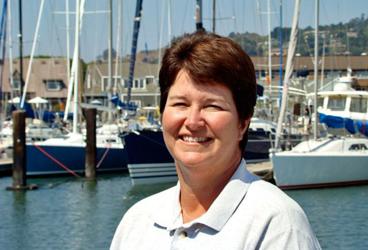
Maxine White
Second Place: Tim Bittel “Lost Backstay Off Bermuda”
Prize: $150 gift card from Landfall Navigation
Three days out of Norfolk, 200 NM northwest of Bermuda, at 0330 Tevai, our Bob Perry designed Laffite 44, lost her backstay in a 35 knot thunder squall. Some “accidents” are really unavoidable but good preparation, aka Safety at Sea, can help avert dire consequences.
I had just purchased a new eye jaw toggle from a respected national supplier and installed it the day before Tevai cleared Norfolk. Ironically, this new piece failed. The remnants showed internal voids; the part was defective.
A hydraulic backstay adjuster was attached, and upon release, the 15 pound cylinder careened though the air, smashing a wind generator blade, plummeting past my head, wrapping itself around stays and smacking into the gel coat. We were at serious risk of being dismasted. But Tevai was up and sailing by 0600 because:
1. Prior to departure in a crew meeting I explained that the air horn in the cockpit was the emergency “all hands on deck” signal;
2. We had very capable, well rested crew;
3. Tevai was being sailed conservatively under staysail with one reef in the main;
4. A running back stay had been rigged;
5. A spare (and quite expensive) mechanical rod assembly was onboard to replace the hydraulic backstay adjuster in the event of damage. In fact, my boatyard had advised to not buy the assembly because it would “never be needed”;
6. Jack lines were rigged and each crew had a harness and tether;
7. We had emergency radio frequencies programmed into the SSB and the designated radio operator was able to get off a “securité” call before the SSB lead parted;
We did everything right, but we were also lucky. The heavy, swinging adjuster could have seriously injured someone; the crew faced unavoidable risk to bravely secure it.

Tevai_, off Hattaras, headed home after two years._
Third Place: Arthur Shaw “Lessons in Pride”
Prize: $100 gift card from Landfall Navigation
Although none aboard Second Wind for our voyage from Seattle to Kauai were strangers to sailing, three of the four were new to ocean passages. However, one member had completed a circumnavigation and recently attained a 100-ton master’s license.
Early into our adventure we found ourselves surrounded in black, with increasing wind and mounting water. Even sailing with just double-reefed main and storm jib, our vessel’s speed continued to accelerate.
I’ve sailed in gale force winds before, but this water was new. Fascinating! Our 12-ton Nordic 44 was lurching and heaving in unpredictable ways, and often with surprising force. I was becoming aware firsthand how the extraordinary size and multidirectional movement of the waves are what separates ocean sailing from inland adventures.
Experienced sailors know “to take care of the ship is to take care of the crew.” As owner and senior member, I assumed I would be the one to go forward to haul down and secure the mainsail. However, our experienced member confidently informed me I was not qualified to work on deck in these conditions–yet. Though taken aback on hearing this, I humbly stepped aside to learn from the professional.
Moving with bent knees, always keeping at least three points in contact with the vessel, working deliberately but not hurriedly, and tackling each task one step at a time, our bluewater pro illustrated how to safely tend to the vessel’s integrity in dangerous conditions. Remaining focused, calm, and tenacious was the primary tutorial.
Many such lessons on our voyage enabled my wife and me to make the return trip without our exemplary leader. But the most impressive discovery was how competent and savvy this particular skipper had become: Captain Shaw, our daughter.

The Shaw family en route to Kauai


